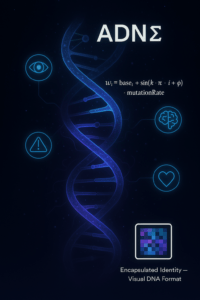🧬 ADNΣ — Mathematical Genome for Emergent Neural Intelligence
In LSARN, artificial life is not scripted — it is encoded. At the core of every agent lies a structure called ADNΣ (Sigma DNA), a fully procedural digital genome that defines morphology, cognition, emotion, memory, and behavior potential.
This system is inspired by real genetics, where not only traits, but also patterns, structures, and behaviors emerge from a compact, mathematically expressive sequence. As modern research shows, biological DNA encodes more than proteins — it hides equations, rhythms, and recursive logic (Futura Sciences, 2023). LSARN applies this same philosophy to artificial minds.
🧠 Genome as Cognitive Blueprint
Each ADNΣ instance is a compact, single-pass structure that governs:
Morphological traits: body size, mass, color spectrum, asymmetry factor, structural index.
Personality factors: aggressiveness, curiosity, sociability, circadian modulation, emotional sensitivity.
Vocal identity: pitch, voice type, and acoustic signature hash.
Species encoding: defining ranges of variability and constraints.
Lineage & parental hashes: for tracking genetic descent and mutations across generations.
🔬 Neurogenesis via Equation-Driven Mutation
The core mechanism behind brain formation in LSARN is deterministic weight synthesis:
wi=basei+sin(k⋅π⋅i+ϕ)⋅mutationRatew_i = \text{base}_i + \sin(k \cdot \pi \cdot i + \phi) \cdot \text{mutationRate}wi=basei+sin(k⋅π⋅i+ϕ)⋅mutationRate
Where:
ϕ\phiϕ is a phase-shifting genetic marker unique to the agent.
kkk is a frequency constant driving neural periodicity.
iii is the index of the synaptic weight.
mutationRatemodulates amplitude and plasticity.
This method avoids randomness in weight initialization and allows predictable, heritable neural structures, where a child brain can statistically resemble its parents, yet still diverge structurally in meaningful ways.
Each brain is composed of modular neural blocks (2 to 7 per agent), with independent input/hidden/output layers — enabling function-specific processing such as memory, emotion, vision, or motor control.
🧬 Inherited Symbolic Memory
Unlike traditional AIs, LSARN agents pass down episodic symbolic memory via ADNΣ buffers. Each memory is encoded as:
symbolCode(ushort): an abstract representation (danger, sound, place…)strength(float): the clarity or emotional weight of the memory
These are limited in number, ensuring a Darwinian selection of memory fragments through lineage.
🖼️ Visual Biocode: The Genome as Image
To ensure cross-platform portability, visualization, and archival of agents, ADNΣ can be losslessly encoded as a PNG texture. This “Visual Biocode” includes:
All ADNΣ fields (traits, modules, weights, symbols)
Encrypted via per-pixel RGBA encoding
Loadable and decodable back into a full neural agent
This mechanism mimics biological visualization of genomes, but in a format usable in a live Unity DOTS simulation.
🧪 Emergence Over Instruction
No agent in LSARN is hand-scripted. All behavior emerges from:
ADNΣ → modular neural networks
Environmental perception (raycasts, sounds, collisions…)
Dopamine-based reward modulation
Emotional feedback
Dream-based memory consolidation
The result: life-like agents with adaptive, reflexive, and sometimes unpredictable behaviors, grounded entirely in a synthetic but mathematically rigorous DNA system.

🛡️ Intellectual Property Notice — ADNΣ Protection
© LIFE Sandbox AI – Neural Networks (LSARN) — All Rights Reserved
The ADNΣ system (Digital Sigma DNA) is a core innovation of LSARN and constitutes an original software creation by Df Games Studio (alias Frédéric D.), protected under French and international intellectual property laws.
This digital DNA technology includes (but is not limited to):
A procedural neural genome architecture encoding modular brain structures, cognitive traits, symbolic memory, and emotional parameters.
A real-time genetic reproduction engine allowing deterministic mutation and neural crossover between AI agents.
A fully encoded Visual Biocode System capable of storing and reloading complete agents via encrypted image formats.
Symbolic memory embedding and emergent personality traits, driven by epigenetic factors and neural feedback.
This system forms the foundation of all adaptive behavior and cognition within LSARN and is entirely original in its design, functionality, and implementation.
No part of the ADNΣ concept — including its structural design, data representation, mutation process, or visual encoding technique — may be copied, modified, decompiled, reverse-engineered, or redistributed in any form, without explicit, written permission from the author.
Any infringement, including unauthorized replication or reuse of the ADNΣ system or its derivatives, will result in legal proceedings under Articles L.335-2 and following of the French Intellectual Property Code, and applicable laws in international jurisdictions.